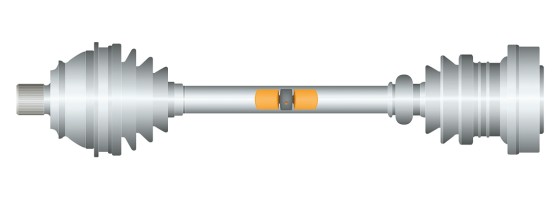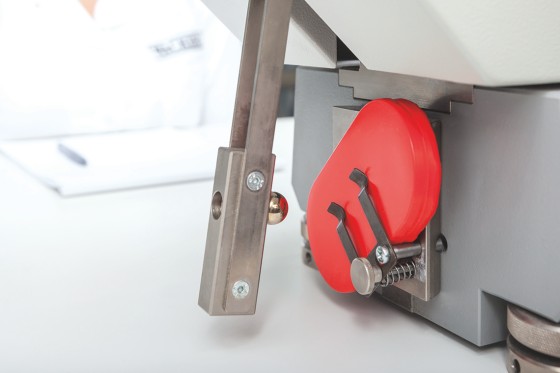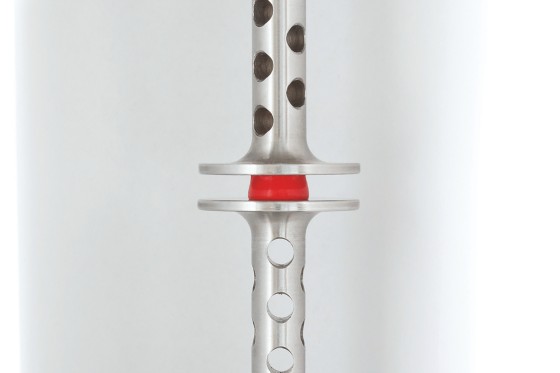Smooth and Quiet
The automotive industry is increasingly using vibration dampers (also known as mass dampers) to prevent vibrations inside cars. Solid silicone rubber grades from WACKER that have strong damping effects help to correctly adjust the components’ vibrational properties. They convert vibrational energy into heat.

Few things irritate the owner of a new car more than experiencing vibrations, rattling or humming in the car’s interior on driving off. Internet forums on the topic are full of such complaints: “At a kilometer reading of 6,400, high-frequency vibrations suddenly started in the steering wheel and could also be felt on the foot support, through the accelerator and in the high-comfort seat, especially in the headrest,” claims the owner of a German premium-range model in one such forum, for example. “At first, it only feels like a very subtle vibration, but after 20 minutes, it’s quite irritating.”
However, vibrations are not just a source of irritation that, at least subjectively, leave an impression of poor quality – they can even cause material fatigue. They are generated by the drive unit and chassis, as a result of the tires making contact with the road. Typically, as described above, they are transmitted to other parts that can vibrate, such as the gearstick, dashboard and steering wheel. If the vibrating parts are big enough, they emit sound waves. This additionally creates unwelcome buzzing and humming noises.
Two Options Available

To counteract vibrations and related noises without having to modify the basic design of the vehicle, car manufacturers essentially have two options: they can either prevent the transmission of vibrations from a strongly vibrating area to other areas, or steady the vibrating components. For the first remedy, they need vibration-decoupling damping elements; for the second, vibration dampers (also known as mass dampers). Both methods increase ride comfort, enhance quality and help to avoid vibration-related damage.
Over recent years, problems relating to undesirable vibrations have intensified in the automotive sector. This is due to engine downsizing and lightweight construction. Powerful engines with reduced cylinder capacity vibrate more strongly than traditional four- or six-cylinder engines with larger capacities. Lighter components and assemblies lead to considerable weight savings, but can vibrate much more easily than heavier parts. As a result, the use of vibration dampers, in particular, is gaining in popularity.
Correct Assembly, Major Effect

Measurement of the rebound properties of ELASTOSIL® R 752: The less the plunger swings back, the better it can absorb vibrations).
This kind of damper acts directly at the vibrating assembly. If it is installed exactly where the vibration amplitude of the vibrating assembly is at its greatest, it can significantly reduce the undesired vibration, steadying the assembly.
A vibration damper is a mass-spring-damper system that is capable of vibrating, and consists of a metal core and rubber-elastic jacket. The metal core acts as the oscillating mass and the jacket takes on the function of spring and damper. The undesired vibrating of the assembly induces the damper to vibrate strongly, too. The vibrating damper almost entirely stops the exciting vibration by continuously drawing energy from it. However, this only works when the damper is tuned to resonate with the vibration that is to be canceled out, i.e. when its natural frequency and the frequency of the exciting vibration are virtually identical.
The natural frequency can be adjusted via the metal core’s weight and via the elastomer’s dynamic mechanical properties. These are properties that describe the elastomer’s viscoelastic behavior in response to a force that changes with time. If a force that periodically changes with time acts on the elastomer, the material deforms periodically – but with a certain time delay. The more the deformation lags behind the acting force, the stronger the material’s damping effect and the lower its elasticity.
Elastic, Yet Damping
ELASTOSIL® R 752
This product range's silicones cure to form elastomers that are significantly less elastic than standard silicone rubber. As a result, they have a strong damping effect on vibrations.
In general, an elastomer used in vibration dampers must be sufficiently elastic to be able to act as a cushioning material. However, it must also possess vibration-damping properties, so that it can convert some of the vibrational energy into heat. The loss factor represents the amount that is converted into heat. It describes the ratio of the energy converted into heat to the energy that is elastically stored in the elastomer. The loss factor is directly dependent on how much the deformation lags behind the acting force.
More Leeway

Dynamic-mechanical analysis of the loss angle: The lower plunger is put under vibration. It is then measured to what degree these vibrations carry over to the upper plunger.
WACKER offers several solid-silicone-rubber product lines with different vibrational properties for the manufacture of vibration dampers. The Group recently completed its ELASTOSIL® R 752 product range, whose cured rubber grades have pronounced vibration-damping effects. “They give silicone processors more leeway than before in tailoring vibration dampers to different customer requirements,” says Dr. Christof Wörner, head of an applications laboratory at WACKER in Burghausen, who was responsible for the development of these specialty rubber grades.
All cured ELASTOSIL® R 752 rubber grades – including all hardness levels covered by this silicone range – have a loss factor of between 0.23 and 0.28. “These silicone elastomers thus convert more than 20 percent of the vibrational energy into heat, which is a very good value,” explains Wörner. Standard silicone elastomers of mid-range hardness have a loss factor of around 0.15; the loss factor of highly elastic grades is only around 0.07. The ability to greatly dampen vibrations is a special characteristic of ELASTOSIL® R 752. “Hardly any other silicone on the market achieves such high loss factors,” stresses Wörner.
“Elastosil® R 752 gives silicone processors more leeway than before in tailoring vibration dampers to different customer requirements.”
Christof Wörner, Automotive Technical Marketing Manager, WACKER SILICONESBroadband Scale
New possibilities are thus opened up for manufacturers of vibration dampers. If a silicone elastomer with pronounced vibration-damping effects is used as a spring-damper component, a damper can reduce vibrations within a relatively wide frequency range – ELASTOSIL® R 752 can be used to make broadband vibration dampers. This is not possible with standard or even highly elastic silicone grades.
The fact that ELASTOSIL® R 752 silicones can be used to adjust vibration dampers over a wide range of frequencies is already being used in the manufacture of internal tube vibration dampers for the drive shafts of cars.
A drive shaft transmits the engine’s torque from the transmission to a wheel. Bending vibrations constantly arise in these shafts when the car is moving. They are caused mainly by bumps on the road, but also by severe changes in the number of shaft rotations during acceleration and braking. Shaft imbalance can also trigger bending vibrations. The vibrating shaft can have many different vibrational states of various frequencies. These vibrations must be reduced as effectively as possible, as they would otherwise significantly impair the ride comfort.
Damper in the Tube
For weight reasons, drive shafts in modern cars are often hollow, i.e. tubular. This means there is sufficient room in their interior for a vibration damper. If the damper is correctly adjusted over a wide enough frequency range and placed in the middle of the hollow shaft, it can weaken the bending vibrations to such an extent as to be no longer felt inside the car.
ELASTOSIL® R 752 solid silicones make ideal elastomer components for internal tube dampers. By virtue of their large loss angles, these silicones provide the necessary conditions for steadying the drive shaft at the frequencies that are relevant to ride comfort. In addition, the cured rubber grades possess all the typical properties of silicones, such as heat resistance, low-temperature flexibility and aging resistance – a big advantage over organic rubber grades. Unlike organic elastomers, silicones have a loss factor that only changes slightly within a large temperature range of -50 to +200 °C. The internal tube damper thus behaves the same during severe northern winter nights as it does in the hottest of desert regions.
“ELASTOSIL® R 752 solid silicone rubber grades have a pronounced damping effect and enable cost-effective production of vibration-reducing components, even in large quantities,” explains Dr. Wolfgang Schattenmann, head of the Rubber Solutions business team at WACKER SILICONES. All of these peroxide-curing solid silicone rubber grades can be processed both by conventional compression molding and by injection molding.
Their applications are by no means confined to automotive technology: “After all, vibration dampers are needed wherever vibrations are a source of irritation,” says Schattenmann.
